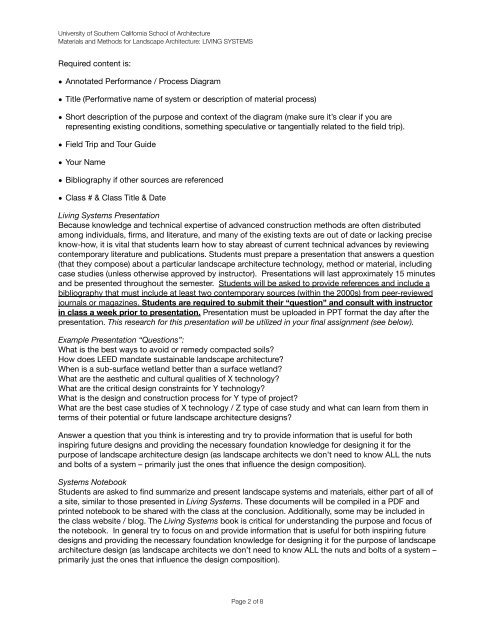2011 Landscape Architecture 535 - USC School of Architecture
2011 Landscape Architecture 535 - USC School of Architecture
2011 Landscape Architecture 535 - USC School of Architecture
You also want an ePaper? Increase the reach of your titles
YUMPU automatically turns print PDFs into web optimized ePapers that Google loves.
University <strong>of</strong> Southern California <strong>School</strong> <strong>of</strong> <strong>Architecture</strong><br />
Materials and Methods for <strong>Landscape</strong> <strong>Architecture</strong>: LIVING SYSTEMS<br />
Required content is:<br />
• Annotated Performance / Process Diagram<br />
• Title (Performative name <strong>of</strong> system or description <strong>of</strong> material process)<br />
• Short description <strong>of</strong> the purpose and context <strong>of</strong> the diagram (make sure it’s clear if you are<br />
representing existing conditions, something speculative or tangentially related to the field trip).<br />
• Field Trip and Tour Guide<br />
• Your Name<br />
• Bibliography if other sources are referenced<br />
• Class # & Class Title & Date<br />
Living Systems Presentation<br />
Because knowledge and technical expertise <strong>of</strong> advanced construction methods are <strong>of</strong>ten distributed<br />
among individuals, firms, and literature, and many <strong>of</strong> the existing texts are out <strong>of</strong> date or lacking precise<br />
know-how, it is vital that students learn how to stay abreast <strong>of</strong> current technical advances by reviewing<br />
contemporary literature and publications. Students must prepare a presentation that answers a question<br />
(that they compose) about a particular landscape architecture technology, method or material, including<br />
case studies (unless otherwise approved by instructor). Presentations will last approximately 15 minutes<br />
and be presented throughout the semester. Students will be asked to provide references and include a<br />
bibliography that must include at least two contemporary sources (within the 2000s) from peer-reviewed<br />
journals or magazines. Students are required to submit their “question” and consult with instructor<br />
in class a week prior to presentation. Presentation must be uploaded in PPT format the day after the<br />
presentation. This research for this presentation will be utilized in your final assignment (see below).<br />
Example Presentation “Questions”:<br />
What is the best ways to avoid or remedy compacted soils<br />
How does LEED mandate sustainable landscape architecture<br />
When is a sub-surface wetland better than a surface wetland<br />
What are the aesthetic and cultural qualities <strong>of</strong> X technology<br />
What are the critical design constraints for Y technology<br />
What is the design and construction process for Y type <strong>of</strong> project<br />
What are the best case studies <strong>of</strong> X technology / Z type <strong>of</strong> case study and what can learn from them in<br />
terms <strong>of</strong> their potential or future landscape architecture designs<br />
Answer a question that you think is interesting and try to provide information that is useful for both<br />
inspiring future designs and providing the necessary foundation knowledge for designing it for the<br />
purpose <strong>of</strong> landscape architecture design (as landscape architects we don’t need to know ALL the nuts<br />
and bolts <strong>of</strong> a system – primarily just the ones that influence the design composition).<br />
Systems Notebook<br />
Students are asked to find summarize and present landscape systems and materials, either part <strong>of</strong> all <strong>of</strong><br />
a site, similar to those presented in Living Systems. These documents will be compiled in a PDF and<br />
printed notebook to be shared with the class at the conclusion. Additionally, some may be included in<br />
the class website / blog. The Living Systems book is critical for understanding the purpose and focus <strong>of</strong><br />
the notebook. In general try to focus on and provide information that is useful for both inspiring future<br />
designs and providing the necessary foundation knowledge for designing it for the purpose <strong>of</strong> landscape<br />
architecture design (as landscape architects we don’t need to know ALL the nuts and bolts <strong>of</strong> a system –<br />
primarily just the ones that influence the design composition).<br />
Page 2 <strong>of</strong> 8
















